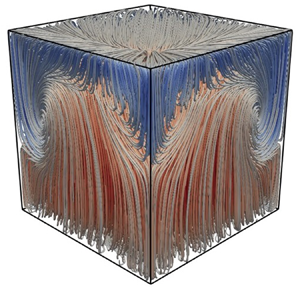Article contents
Evaporation-driven turbulent convection in water pools
Published online by Cambridge University Press: 08 October 2020
Abstract

In this paper we study turbulent thermal convection driven by free-surface evaporation at the top and a uniformly heated wall at the bottom. More specifically, we report on direct numerical simulations over 1.25 decades of Rayleigh number, Ra. At the top of the cubic domain, a shear-free boundary condition acts as an approximation of a free surface, and different evaporation rates form the basis of a temperature gradient assigned as a non-zero Neumann boundary condition. The corresponding lower wall temperature is fixed and we assess the thermal mixing on the water side of the air–water interface. The set-up is considered a simplified model of the turbulent natural convection in the upper volumes of spent-fuel pools of nuclear power plants. Surface temperatures are investigated over a range of 40 K, resulting in a sixteenfold increase in evaporation rates. Our work allows, for the first time, analysis of the features and mean flow statistics of this particular thermal convection configuration. Results show that a shear-free surface increases heat transfer within the domain; however, the exponent in the diagnosed power-law relation between the Nusselt and Rayleigh numbers,  $Nu = 0.178Ra^{0.301}$, is similar to that of classical turbulent Rayleigh–Bénard convection. Further, the free slip accelerates the fluid after impingement on the upper boundary, significantly affecting the structure of the large-scale circulation in the container. Analysis of the flow statistics then shows how the shear-free surface introduces inhomogeneities in thermal boundary layer heights. Overall, the investigated turbulent convection configuration shows unique traits, borrowing from both turbulent Rayleigh–Bénard convection and evaporative cooling.
$Nu = 0.178Ra^{0.301}$, is similar to that of classical turbulent Rayleigh–Bénard convection. Further, the free slip accelerates the fluid after impingement on the upper boundary, significantly affecting the structure of the large-scale circulation in the container. Analysis of the flow statistics then shows how the shear-free surface introduces inhomogeneities in thermal boundary layer heights. Overall, the investigated turbulent convection configuration shows unique traits, borrowing from both turbulent Rayleigh–Bénard convection and evaporative cooling.
JFM classification
Information
- Type
- JFM Papers
- Information
- Copyright
- © The Author(s), 2020. Published by Cambridge University Press
References
REFERENCES
- 15
- Cited by


